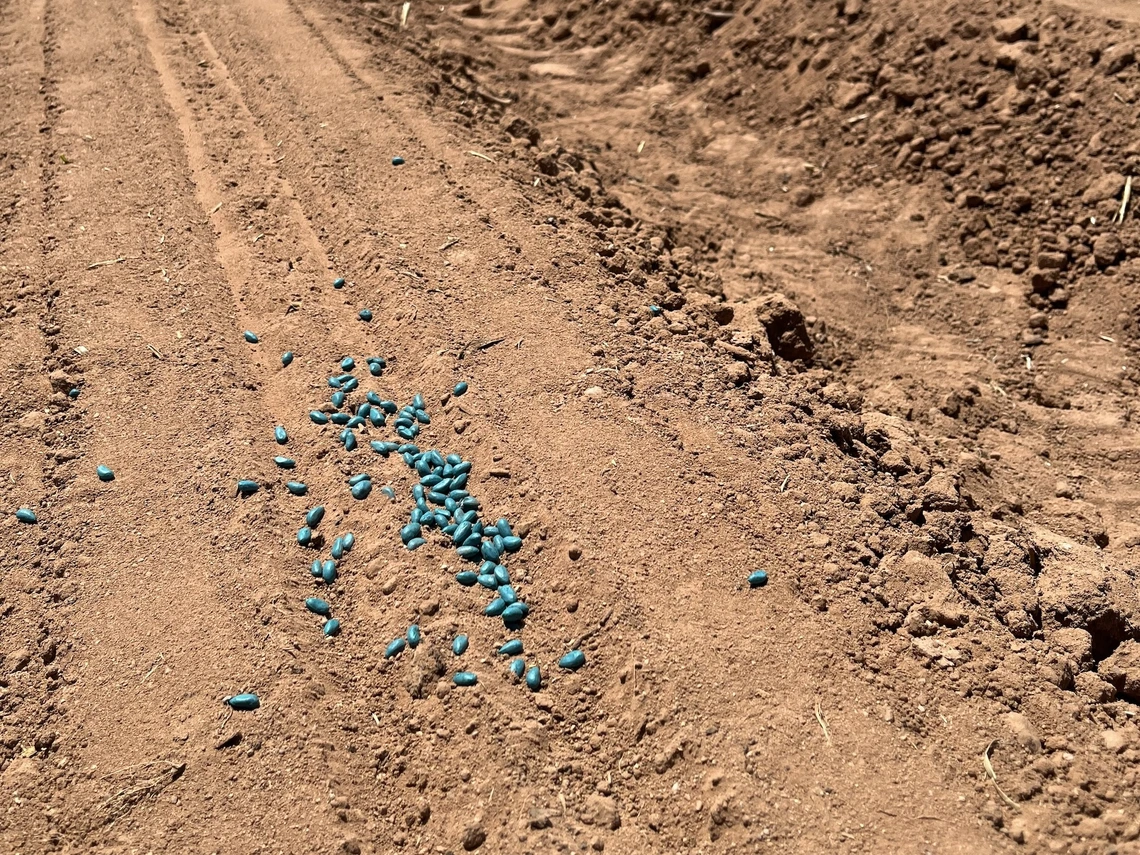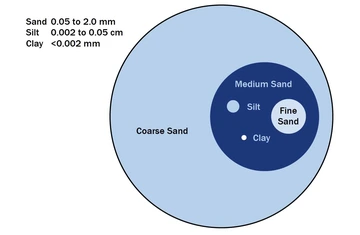The following information is from the Arizona Master Gardener Manual, which is published by University of Arizona Cooperative Extension.

University of Arizona Cooperative Extension is researching cotton in the sandy soil at the Maricopa Agricultural Center near Phoenix.
Brad Poole, Cooperative Extension
What is soil?
Soil is the unconsolidated mineral and organic matter on the surface of the Earth. It serves as a medium for the growth of land plants.

Cooperative Extension
Organic matter is made up of remains or by-products of living organisms. A surface soil ideal for plant growth typically contains about half solid material and half open space. The solid material is primarily minerals with a small amount of organic material. The mineral content includes many kinds and sizes of particles, from those visible to the unaided eye to microscopic. Typically, just 1 to 3 percent of the solid material in soil is organic.
Under ideal growing conditions, about half of the empty space in soil is water-filled, meaning about 25 percent of soil is air and 25 percent water. These percentages change after rainfall or during dry periods. Increasing organic matter content usually increases water-holding capacity.
Most Arizona soils developed under arid or semi-arid conditions. But because of different in elevation, landscapes and climate, soils differ across the state. Arizona soils typically contain very low levels of organic matter, usually less than 1 percent by weight, due to limited organic production and rapid decomposition in warm soils. But soils with poor drainage or high water tables contain more organic matter than those which are well drained, and soils that are not cultivated for long periods contain more organic matter.
Jump To:
Properties of soil
Classes
Sand, silt, and clay are referred to as soil separates. Soil texture depends on the amount of sand, silt and clay. In each class, there is a range of sand, silt, and clay.

- Loam – Loams exhibit properties of sand, silt, and clay in approximately equal proportions.
- Sandy loam – Varies from very fine loam to very coarse. Feels quite sandy or gritty, but contains some silt and a small amount of clay. The amount of silt and clay is sufficient to hold the soil together when moist.
- Silt loam – Silt is the dominant particle in silt loam, which feels quite smooth or floury when rubbed between the thumb and fingers.
- Silty clay loam – Noticeable amounts of both silt and clay are present.
- Clay loam – Clay dominates clay loams, which are smooth when dry and slick/sticky when wet. Silt and sand are present in noticeable amounts in this texture class, but are overshadowed by clay.
Color
In general, soil color is reflective of organic matter content, drainage conditions and degree of oxidation or extent of weathering. Soil coloration also may be due to the colors imparted by the parent material.
Light or pale colors indicate relatively coarse textures, highly leached conditions and high annual temperatures. Dark colors can indicate prolonged wet conditions or low annual temperatures, conditions that slow organic decomposition.
Temperature
Soil temperature depends on air temperature and solar radiation.
In the summer, soil temperatures can be considerably higher than air temperature. Darker soil surfaces absorb more solar radiation and are hotter than light-colored surfaces that reflect sunlight. Light colored mulch can reduce soil temperature by reflecting sunlight and by insulating the soil surface, while dark mulch can raise soil temperatures. Clear plastic mulch increases soil temperature more than black mulch, but allows weeds to grow under the mulch. Infrared transmitting (IRT) allows warming solar radiation to pass through to the soil, but prevents transmittance of light wavelengths necessary for photosynthesis, so weed growth is eliminated. White or reflective mulches reduce soil temperatures.
Water and air
The amount of water a soil can hold is called the field capacity. Clay soils have high field capacity; sands have low field capacity. Plants must overcome the attraction between water and soil particles in order to draw water out of the soil. When a plant runs out of water, soils are not completely dry, but contain water held too tightly for the plant to extract. This is called the permanent wilting point.
Testing drainage
To test soil drainage, dig a hole approximately a foot across and a foot and a half deep. Fill the hole with water. Let the soil absorb the water for one to two hours. Then fill it again with water. The hole should drain within 24 hours. If not, then plants should not be planted in that location without improving drainage. Physical barriers such as caliche can be broken by digging, allowing improved drainage.
Components
Nutrients
Plants need 17 elements for normal growth and reproduction. These are nutrients, otherwise known as essential elements.
Carbon, hydrogen and oxygen come from air and water, and make up about 45 percent of a plant’s dry weight. Six of the remaining nutrients, the macronutrients, are needed in relatively large amounts by plants. These are nitrogen, phosphorus, potassium, calcium, magnesium and sulfur.
Nitrogen in the air is unavailable for plant use. However, specialized bacteria in nodules in the roots of legumes can convert nitrogen from the air into a form available to plants. Beans, peas, mesquite, palo verde, acacias, ironwoods and alfalfa are examples of legume plants.
Other nutrients come directly from the soil. Except for nitrogen, phosphorus and iron, there is usually a large enough quantity of each of these elements in Arizona soils for good plant growth.
Clay minerals and cation exchange capacity
The mineral clay in soil differs from minerals in silt and sand. Most clay particles are layered crystalline silicate. Due to their structure, most have a negative electrical charge, which attracts cations, which have a positive charge. Soils vary in the quantity of cations they can hold, measured as cation exchange capacity.
Major soil cations include several important plant nutrients, among them ammonium nitrogen (NH₄+), potassium (K+), calcium (Ca+2) and magnesium (Mg+2). Soils with high cation exchange capacities have a greater capacity to hold and supply these nutrients than low cation exchange capacity soils.
Organic matter
Organic matter in soil consists of the remains of plants and animals. When temperature and moisture conditions are favorable, earthworms, insects, bacteria, fungi and other types of plants and animals use the organic matter as food, breaking it down into humus – the organic matter that remains after most decomposition has taken place – and soluble nutrients.
The amount of organic matter in soil depends on the balance between organic production and decomposition. Cold and wet environments slow breakdown and lead to accumulation in the soil, whereas warm soils encourage decomposition. Hot deserts produce relatively small amounts of plant material, and what is produced decays rapidly, so desert soils contain particularly low concentrations of organic matter.
Soil pH
The pH (potential Hydrogen) of your soil is a measure of the hydrogen ion (H+) activity. The reading expresses the degree of acidity or alkalinity. A pH of 7 is neutral. Values below 7 are acidic, and values above 7 are alkaline.
Soil additives can raise or lower pH. Most central and southwestern Arizona soils are alkaline. In alkaline soils, pH can be reduced with additives, such as elemental sulfur, although this is not usually feasible on a large scale. In acidic soils typical of some parts of northern and southeastern Arizona, pH can be raised with agricultural lime. Wood ashes should not be applied to garden soils, because the pH can inadvertently be raised to undesirable levels.
Salts
An important principle for irrigated soils is that soluble salts are transported by water. Therefore, salinity can be managed by irrigation practices, provided the water is high enough quality and flow can be controlled.
Salts are continually added to soils through precipitation, dust, fertilizers and irrigation. Unless salts are removed as fast as they are added, they will accumulate. Salt-damaged plants appear much like drought-damaged plants, although salt tolerance varies widely among species.
Organic matter also can help to overcome effects of sodium by increasing soil aggregation, infiltration rate and water-holding capacity. However, some animal manures contain soluble salts and can increase salinity.
Testing
Soil testing can reveal texture, nutrient status, pH, electrical conductivity (EC, a measure of salinity) and sodium adsorption ratio (SAR) or exchangeable sodium percentage (ESP) – both measures of the influence of sodium.
A basic soil test usually includes nitrate-nitrogen, phosphorus, potassium, calcium, magnesium and sodium content, pH, and EC. Additionally, free lime and SAR or ESP are usually tested on alkaline or sodic soils. Testing for micronutrients usually is not needed.
A list of testing facilities can be found in this University of Arizona Cooperative Extension publication. Contact a soil testing laboratory to find out how much sample they require for the tests you want and how they want the sample handled.
Home soil testing kits are not as accurate as lab testing and some are very poor.

